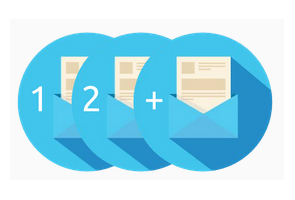Let me get this out of the way early on: I love email. I’m a huge believer in the power of a strong, engaged list, mostly because I’ve seen many marketers leverage email and turn profits that have to be seen to be believed.
When you run a copywriting company, you get a lot of requests, but I’ve found that we also get a lot of clients asking us, “well, what do you think we should do?” when it comes to content that’s going to convert.
There are few forms of content that have the sheer number of possible answers that email does. Email is a powerful marketing tool, but just like anything else, you need to have the right tool for the job.
If I were to make a comparison, I think I would compare email to screwdrivers. You don’t use the same screwdriver on the screws in your kitchen cabinets as you do on the ones in your glasses. Why? Because the one that fits the glasses won’t fit the cabinets and vice-versa.
Take an eyeglass-size screwdriver and put it in a larger screw, and all you’re going to do is constantly turn, turn, turn, expending energy with no results. That’s why I decided to tackle this subject today: to help you find the right email sequence to get the job done.
Universal Rules
When it comes to email, there are a few universally relevant tips that I can share with you. For starters, every product or service that exists is there to solve a problem. It’s important to realize this when you’re writing your emails. That problem and its solution need to be the foundation of everything you say about the product. Why? Because the product is the solution. Moreover, it’s the only viable solution. The rest of your sequence is now going to be about backing up that opinion with compelling copy.
Next, email is a conversation. Emails seeded with sales pitches that talk “at” the reader get deleted, as do all subsequent messages from you. Figure out how to be relatable and inspiring. An ounce of enthusiasm can keep the reader on the hook for days or more.
Finally, there is no set formula for what will work and what won’t. The biggest question we get about emails is, “How many messages should we send?” The answer is always the same: “That depends.” On what? Read on…
Product Launches
When launching a new product, it’s helpful if you’ve already established a list through other lead-generating means and directed email addresses into a funnel that is likely to respond favorably to the product.
How long should a product launch sequence be? That depends on its intent. Are you planning to build or expand on the product in the future? If so, you want to leave the message in your emails more open-ended. You want to talk up the problem and define where the solutions are going to come from. Once you’ve established yourself as an authority, you can keep going back with new products indefinitely. Notice I’m not giving a straight answer to the question. Why? Because, “It depends…”
Ongoing Sequences
The best way to maintain customers is to always be in front of them, not in an annoying or invasive way, just in a present way. Be present in their inboxes and put things in there that will be interesting and fun to read, not necessarily selling or even linking to a product every single time. Remember, this is a conversation, and good conversations can last a long time. So how many emails should you send before you actually try to sell something? Do I really need to type the answer again?
Cart Abandons, Pre-Sells, Expiring Discounts
The running theme throughout all of these sequences is urgency. Your job is to get the reader to make a decision and make it now. Here I will give you my opinion on the length of a sequence. Most of the time, you want to seal the deal inside of 3-4 days.
It’s also helpful if your messages include a countdown of sorts. On day one, you let them know they have three days left. On day two, you let them know the clock is ticking, and so on until your final message that comes with a huge warning that the offer absolutely expires at midnight (or whenever you’ve decided to end it).
Cart abandons and pre-sell emails are also a great place to drive the key benefits and offer discounts and incentives for capturing the sale. One of the simplest and most effective methods that one of my copywriters swears by is the 4 Day Cash Machine, although if you ask him, he’ll tell you that you need to provide a more personal touch to your sequence for it to work. Always drive the benefits, always mention the problem or “pain” that the product deals with, and emphasize scarcity and urgency.
“It Depends…” on WHAT?
As a final note, I just want to say one more thing about the whole “it depends…” concept, and that is that email sequences are like snowflakes. There are no two that are exactly alike, so what does it depend on?
It depends on what works.
Sometimes it takes some trial and error to figure out what’s going to get through to a specific audience, but once you figure it out, you have a lot to go by. Don’t get lazy, though. Every product, every lead, and every funnel is going to present you with its own unique success formula. Master the basics, and you’ll spend less time starting completely from scratch and more time building stronger relationships with the people on your lists.
